Kohlrabi Farming
Kohlrabi cultivation is becoming increasingly popular due to its high profitability and nutritional value. This cool-season vegetable, recognized for its swollen, turnip-shaped stem, thrives best in fertile, well-drained soils with adequate irrigation and proper care.
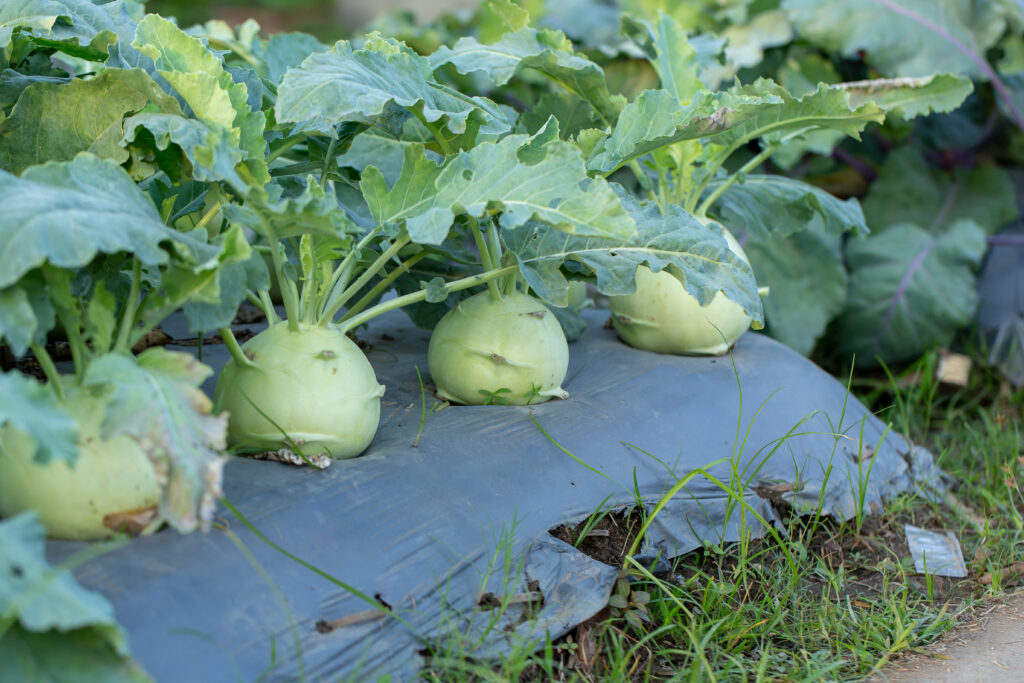
It has a relatively short maturity period of about 60–80 days, allowing farmers to harvest multiple times within a year. With rising demand in both rural and urban markets, kohlrabi farming provides a dependable income source for growers while supplying consumers with fresh and healthy produce.
Kohlrabi farming profit per acre is highly promising, making it an attractive option for commercial vegetable growers. An economic analysis shows that with a total investment of NRs. 57,000, farmers can generate a total income of around NRs. 220,000 per acre, resulting in an impressive net profit of NRs. 163,000.
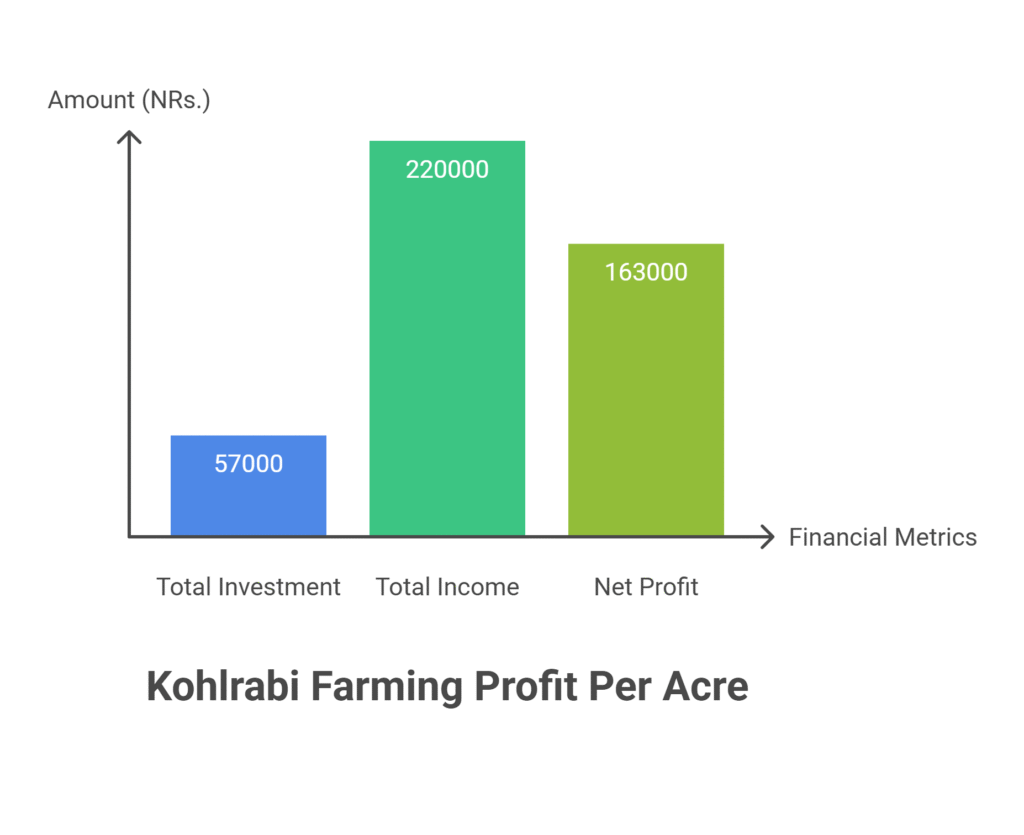
The Benefit-Cost Ratio (BCR) is 3.86, which means that for every rupee invested, nearly 3.9 rupees are returned, reflecting an excellent return on investment. Moreover, the profit margin reaches 74.1%, indicating that a major portion of the income remains as pure profit even after covering production expenses. Such strong profitability highlights kohlrabi as a highly rewarding crop under proper management and favorable market conditions.
Land Preparation
Land preparation aims to create a fine, well-drained, and weed-free seedbed that supports strong root development and proper bulb formation. The process begins with deep plowing (15–20 cm) using a moldboard plow about 3–4 weeks before planting to bury weeds and crop residues, improve aeration, and enhance water infiltration.
This is followed by 2–3 harrowings to break soil clods, evenly incorporate organic matter or manure, and level the field. Finally, the soil should be prepared to a loose, crumbly texture without large lumps, and in heavier soils or high-rainfall areas, raised beds of 15–20 cm height is recommended to improve drainage and minimize waterlogging.
Soil Type
The ideal soil for cultivation is well-drained, deep, and fertile sandy loam to loam soils rich in organic matter, though the crop can also grow in clay loam to silt loam provided drainage is excellent. It thrives best in a slightly acidic to neutral pH range of 6.0–7.5, as soil pH below 5.5 greatly increases the risk of clubroot disease. Above all, proper drainage is critical, since waterlogged conditions stunt plant growth and encourage root rot diseases.
Climatic Requirements
Climatic requirements for this crop are specific, as it performs best under cool-season conditions. The optimal temperature range for growth is 15°C to 20°C (59°F to 68°F).
For germination, the ideal temperature lies between 18°C and 25°C, ensuring uniform and healthy sprouting. Bulb development thrives in cool conditions, but when temperatures consistently rise above 25°C (77°F), bulbs often become woody, tough, and overly pungent, with a higher risk of premature bolting (flowering).
In terms of frost tolerance, young plants can withstand light frosts, while mature bulbs are more sensitive. They can tolerate brief, mild frosts, but hard freezes can cause severe damage to the bulbs.
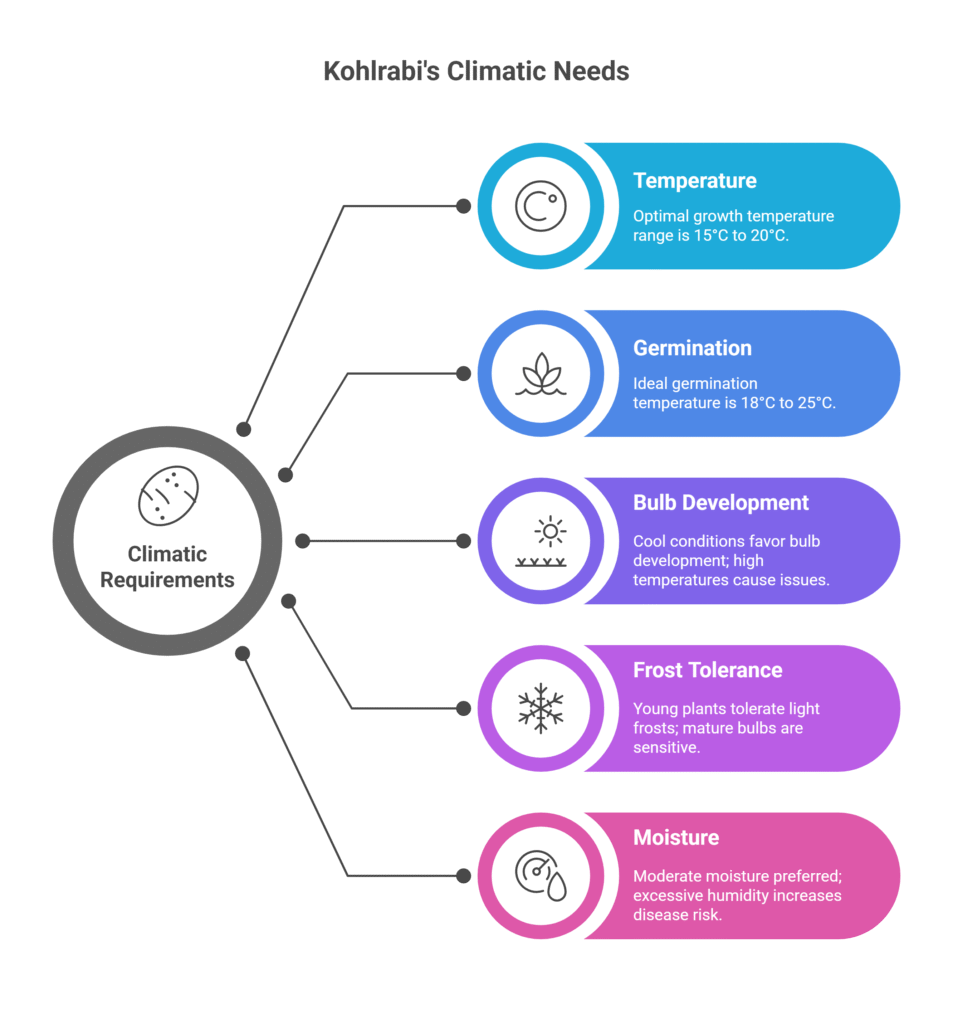
The crop also prefers moderate and consistent moisture. It can adapt to both humid and relatively dry regions if irrigation is available. However, excessive rainfall or humidity significantly increases the risk of disease outbreaks.
Major Cultivars
Kohlrabi Cultivar Classification
| Classification | Cultivar Examples | Key Characteristics |
| By Bulb Color | ||
| Purple/Red | ‘Kolibri’, ‘Rapid’, ‘Azur Star’, ‘Purple Vienna’ | Often slightly hardier and more bolt-resistant. Skin is purple, flesh is white. Visually striking. |
| White/Green | ‘Winner’, ‘Superschmelz’, ‘Korist’, ‘White Vienna’, ‘Grand Duke’ | Most common type. Known for tenderness and mild flavor. Includes both giant and smaller, faster-maturing varieties. |
| By Maturity | ||
| Early (40-50 days) | ‘Winner’, ‘Kolibri’ (F1), ‘Rapid’ | Ideal for quick spring crops or succession planting. |
| Mid-Season (55-65 days) | ‘Korist’ (F1), ‘Azur Star’ (F1), ‘Grand Duke’ (F1) | Standard season length for most gardens. |
| Late (70-80+ days) | ‘Superschmelz’ (Giant White) | Known for its excellent storage potential |
Propagation
Kohlrabi is grown only from seeds, using either direct seeding or transplanting methods. In direct seeding, seeds are planted straight into prepared field beds at the recommended spacing, whereas in transplanting, seeds are first started in a nursery, where seedlings are nurtured for 3–5 weeks before being moved to the main field. Transplanting is often favored because it promotes uniform plant growth, ensures proper spacing, and helps extend the growing season.
Seed Rate per Acre
| Method | Seed Rate per Acre | Notes |
| Direct Seeding | 250–350 grams | Higher seed rate is used to allow for thinning. |
| Transplanting | 100–150 grams | Sufficient to raise seedlings in a nursery. |
Nursery Management
For transplanting, nursery management begins with selecting a sunny, protected site with good drainage near a reliable water source. Raised beds about 1 m wide and of convenient length should be prepared with fine tilth, incorporating well-decomposed compost or FYM into the topsoil.
Seeds are sown thinly in shallow furrows 1–1.5 cm deep, spaced 5–7 cm apart, then lightly covered with soil or sand and watered gently. The seedbed must be kept consistently moist, preferably using fine sprinklers in the early stage. Once seedlings have 1–2 true leaves, thinning to 3–4 cm apart prevents overcrowding and supports healthy growth.
Before transplanting, seedlings should be hardened off by gradual exposure to outdoor conditions such as sun, wind, and cooler temperatures for 5–7 days to minimize shock. Transplanting is done when seedlings are 3–5 weeks old, bearing 4–6 true leaves and pencil-thick stems, while avoiding root-bound or overly tall, leggy plants.
Planting
a). Planting Season
In tropical and subtropical highlands, kohlrabi should be planted during the coolest months, typically from October/November to February/March, when temperatures remain consistently within the optimal range for growth.
In temperate regions, kohlrabi can be grown as both a spring and fall crop. For spring planting, transplant seedlings 2–4 weeks before the last expected frost or direct seed as soon as the soil is workable. For the fall crop, transplant 6–8 weeks before the first expected frost or direct seed in mid to late summer.
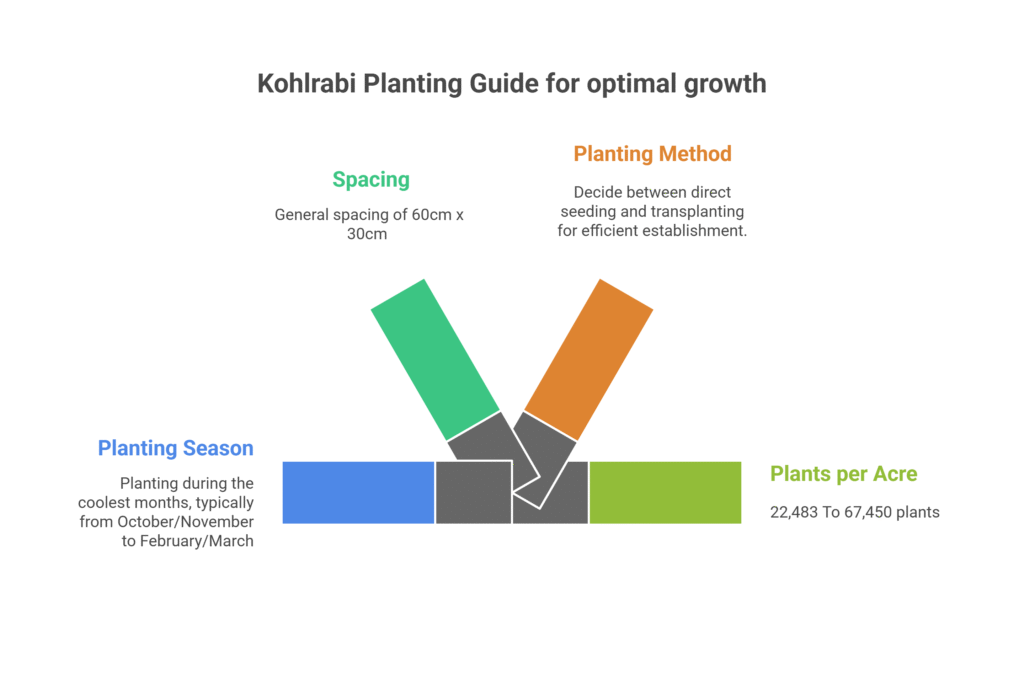
b). Spacing
| Variety Type | Spacing Between Plants | Row Spacing |
| Early maturing / Small varieties | 20 cm | 45 cm |
| Mid to late maturing / Large varieties | 30 cm | 60 m |
c). Planting Method
Direct Seeding
Sow seeds 1–1.5 cm deep, either at the final spacing or slightly closer if thinning will be done later.
Transplanting
When transplanting, create holes just a bit larger than the root balls of the seedlings, following the recommended spacing. Position the seedlings at the same depth they grew in the nursery, since planting them too deep can restrict bulb growth. Lightly firm the soil around the roots and water well right after planting to support successful establishment.
d). Number of Plants per Acre
| Variety Type | Plant Spacing | Number of Plants per Acre |
| Early / Small | 20 cm × 30 cm | 67,450 |
| Mid / Late / Large | 30 cm × 60 cm | 22,483 |
Intercropping
Kohlrabi can be successfully intercropped with short-duration crops such as lettuce, radish, spinach, bush beans, onions, garlic, and herbs like dill or coriander, while avoiding other large brassicas or heavy feeders that compete for nutrients and space. Intercropping offers benefits like more efficient land use, better weed suppression, potential disruption of pests, and additional income. It is important to maintain adequate spacing to allow kohlrabi plants to develop full-sized bulbs without being shaded or crowded by intercrops.
Irrigation
Consistent soil moisture is essential for kohlrabi, as it supports rapid growth and the development of tender, non-woody bulbs, while fluctuations can lead to cracking. Light, frequent irrigations are recommended, particularly during bulb formation, keeping the top 15–20 cm of soil evenly moist but not waterlogged.
Drip irrigation is ideal for efficiency, reducing leaf wetting and targeting the root zone, while sprinklers are acceptable though they may increase foliar disease risk, and furrow irrigation can be used only if drainage is excellent. Critical stages for irrigation include germination, seedling establishment, and active bulb enlargement. Watering should be slightly reduced as bulbs approach maturity to enhance firmness and storage quality, ensuring drought stress is avoided.
Fertilizer and Manure
Applying fertilizer and manure should follow the guidelines in a soil test report to guarantee precise nutrient dosage and ideal crop growth.
| Application Stage | Fertilizer Type | Recommended Dosage | Key Notes / Purpose |
| Land Preparation | Well-decomposed FYM/Compost | 15-20 tons | Incorporated into the soil to improve organic matter and soil structure. |
| Basal Application (At Planting) | NPK (Balanced) | 50 kg N, 50 kg P₂O₅, 50 kg K₂O | A common mix: 110 kg Urea + 310 kg SSP + 85 kg MOP. Adjust based on soil test. |
| Biofertilizers | Azospirillum: 800g PSB: 800g Potash Mobilizing Bacteria: 800g | Applied to enhance nutrient availability and uptake. | |
| Top Dressing (3-4 weeks after planting) | Nitrogen | 25-30 kg N | Applied as ~55 kg Urea when bulbs begin to swell. Incorporate lightly and irrigate. |
| As Needed (Based on soil test) | Micronutrient (Boron) | Borax: 1-1.5 kg | Corrects or prevents boron deficiency, which can cause hollow stems. |
Weed Control
Weed management is a critical component of growing kohlrabi, as weeds aggressively fight for essential resources like nutrients, water, and sunlight. This competition is most damaging during the crop’s early development.
Several effective control methods are available. These include carefully applying pre-emergent herbicides according to label instructions, performing shallow cultivation between rows to avoid harming the kohlrabi roots, and regular hand-weeding directly around the plants.
Furthermore, applying mulch is highly beneficial. Organic options like straw or dry leaves, as well as plastic mulch, are effective at suppressing weed growth, conserving soil moisture, and moderating temperature. Plastic mulch must be anchored properly after the plants are established.
Inter Culture Operation
Interculture operations in kohlrabi include removing the oldest, yellowing, or damaged leaves that touch the ground to enhance air circulation around developing bulbs and reduce the risk of disease. Care should be taken not to remove healthy, functional leaves that contribute to the plant’s growth.
Flowering and Fruit Management
Bolting, or premature flowering, is a major issue in kohlrabi cultivation that renders the bulb woody and inedible. This undesirable process is primarily caused by environmental stresses, most notably when young plants undergo a period of cold vernalization before experiencing warm weather. Other catalysts include prolonged high temperatures and significant stress from drought or nutrient deficiency.
To manage this, a multi-faceted approach is required. Key strategies include careful timing of planting to avoid temperature extremes, choosing varieties specifically bred for bolt resistance, and ensuring consistent care to prevent plant stress. The most direct form of management is to harvest the kohlrabi bulbs as soon as they mature to preempt any trigger from rising temperatures, and to promptly remove any plants that have already bolted.
Pest and Disease Management
Common Pests
Aphids
Aphids can spread viruses and feed on plant sap, which can negatively impact growth. Control methods include neem oil at 2-3 mL/L, insecticidal soap at 2-3 mL/L, or a powerful water jet to remove them. It can also be beneficial to introduce natural predators like ladybugs. Systemic insecticides, such as imidacloprid at 0.3–0.5 g/L, can be used for severe infestations in accordance with package directions.
Cabbage Loopers / Imported Cabbageworm
These pests chew holes in leaves, reducing yield and quality. Control options include Bacillus thuringiensis (Bt) at 1–2 g/L, spinosad at 0.5–1 mL/L, or hand-picking larvae. Row covers can prevent infestation during early growth stages.
Flea Beetles
Tiny beetles create small “shot holes” in leaves, particularly harmful to seedlings. Preventive measures include using row covers at planting. Insecticides such as pyrethrins at 1–2 mL/L or carbaryl at 1–2 g/L can be applied if necessary. Diatomaceous earth sprinkled around seedlings also provides protection.
Cutworms
These larvae cut seedlings at the soil line, often killing young plants. Management includes placing collars around transplants, tilling soil thoroughly before planting, and setting bait traps. Insecticides like chlorpyrifos at 2 mL/L can be applied at dusk for severe infestations.
Cabbage Root Maggot
Larvae feed on roots, stunting plant growth or causing death. Control involves securing row covers at the edges, applying beneficial nematodes, or drenching the soil with insecticides such as diazinon at 1–2 g/L at the time of transplanting.
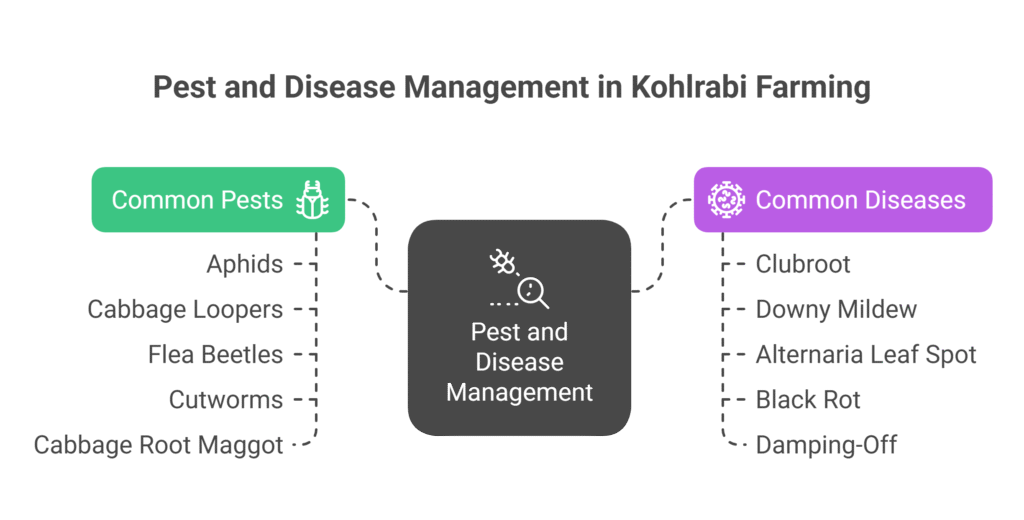
Common Diseases
Clubroot (Plasmodiophora brassicae)
Clubroot is a serious soil-borne disease that causes swollen, distorted roots and stunted plant growth. Management focuses on prevention, including long crop rotations of 4–7 years away from brassicas, maintaining soil pH above 7.2 using lime, planting resistant cultivars where available, improving soil drainage, and sanitizing tools and equipment. Once established, clubroot is extremely difficult to control chemically.
Downy Mildew
A symptom of this disease is the appearance of yellow spots on the top of leaves, accompanied by a white or purple mold growth on the underside. It develops best in cool, wet conditions. Management techniques include using resistant varieties, improving airflow, refraining from overhead irrigation, and using fungicides such as mancozeb or chlorothalonil at a rate of 2-4 grams per liter.
Alternaria Leaf Spot
Alternaria causes dark brown to black concentric ring spots on leaves, reducing photosynthesis and yield. Management involves fungicide application with mancozeb at 2–3 g/L or copper-based fungicides at 2–3 g/L, removing infected plant debris, and practicing crop rotation to reduce inoculum.
Black Rot (Xanthomonas)
Black rot presents as V-shaped yellow lesions starting at leaf edges with blackened veins and is seed- or soil-borne. Control includes using disease-free seed, hot water seed treatment, long crop rotations, avoiding overhead irrigation, and applying copper-based sprays at 2–3 g/L to protect plants.
Damping-Off (Pythium, Rhizoctonia)
This affects seedlings, causing them to collapse at the soil line. Prevention includes using well-drained soil, avoiding overwatering in the nursery, planting fungicide-treated seeds, and ensuring good air circulation around seedlings. Fungicides like metalaxyl at 1–2 g/L can be used for high-risk situations.
Harvesting
To get high-quality kohlrabi, harvest timing is essential. The ideal bulbs are firm and well-swollen, with a diameter of 5 to 8 cm (2 to 3 inches), or around the size of a tennis ball. Harvesting must be done quickly because if you let the bulbs become bigger, like a softball, they will become woody, tough, and smell too strong.
Care must be taken during the harvesting process to guarantee that the bulbs store well and are not harmed. Make sure a tiny piece of the main stem is still attached by cutting it just below the bulb with a sharp knife. It is necessary to eliminate the root system. In order to protect the bulb and stop moisture loss, cut off the larger leaves next, leaving around 2 to 5 cm (1 to 2 inches) of the leaf stalks remaining. To prevent their delicate skin hurt, handle the gathered bulbs with care at all times.
Use succession planting to provide a steady supply of kohlrabi all season long. During the appropriate growing period, make modest new plantings every two to three weeks rather than planting all your seeds at once. A consistent and prolonged output is ensured by this staggered technique, which means that while one batch is ready for harvest, another is still maturing.
Yield
On average, kohlrabi produces 10,000 to 15,000 kg per acre, equivalent to roughly 10–15 tonnes per acre.
Cost of Investment per acre for Kohlrabi Farming
| S.N. | Categories | Cost of Investment (NRs.) |
| 1 | Land Preparation | 15,000 |
| 2 | Seed | 2,000 |
| 3 | Nursery Management | 5,000 |
| 4 | Transplanting | 4,000 |
| 5 | Fertilizers and Manure | 8,000 |
| 6 | Irrigation | 5,000 |
| 7 | Weed Control (Pre & Post-emergence) | 3,000 |
| 8 | Pest & Disease Control | 3,000 |
| 9 | Harvesting | 7,000 |
| 10 | Miscellaneous Costs | 5,000 |
| Total Cost | 57,000 |
Income per acre for Kohlrabi farming
| Particulars | Estimated Yield / Acre (Kg) | Market Price (NRs. /Kg) | Total Income (NRs.) |
| Yield | 11,000 | 20 | 220,000 |
Analysis of Kohlrabi farming profit per acre
| Metric | Calculation | Amount (NRs.) |
| A. Total Income | 220,000 | |
| B. Total Investment | 57,000 | |
| C. Net Profit | A – B | 163,000 |
| D. Benefit-Cost Ratio (BCR) | (Total Income / Total Cost) | 3.86 |
| E. Profit Margin | (Net Profit / Total Income) * 100 | 74.1% |
Kohlrabi farming demonstrates high profitability, generating a strong net profit of NRs. 163,000 per acre, which highlights its potential as a lucrative enterprise under proper management. The Benefit-Cost Ratio (BCR) of 3.86 indicates an excellent return on investment, meaning that for every 1 Nepalese Rupee invested, farmers can expect a return of about NRs. 3.86.
Since a BCR greater than 1 is considered profitable, this high value reflects an efficient and rewarding venture. Additionally, the profit margin stands at 74.1%, showing that nearly three-quarters of the total revenue is pure profit after covering production costs, making kohlrabi a highly attractive crop for commercial cultivation.
Crop Calendar for Kohlrabi Farming
| Stage | Time Period / Growth Stage | Key Activities | Inputs & Specifications | Purpose & Best Practices |
| 1. Pre-Planting & Land Preparation | 2–3 weeks before sowing/transplanting | • Deep plowing (15-20 cm) • 2-3 rounds of harrowing or rotavating • Leveling the field • Forming raised beds (if needed) | • Tractor with moldboard plow and harrow • 15-20 tons/acre of well-decomposed Farmyard Manure (FYM) or compost | Bury crop residues, improve aeration, incorporate organic matter, create a fine, well-drained seedbed to support root development. |
| 2. Sowing / Nursery Raising | Main Season: Sept–Oct Spring Season: Feb–Mar | • Sowing seeds in prepared nursery beds or seedling trays • Light watering after sowing • Thinning seedlings (if overcrowded) | • Seed Rate: 100-150 gm/acre for transplanting • Spacing: Sow seeds 5-7 cm apart in rows • Light irrigation (sprinkler) | To produce healthy, robust seedlings (4-5 true leaves) ready for transplanting in 25-30 days. Use a protected nursery for extreme weather. |
| 3. Transplanting | 25–30 days after sowing (at 4-5 leaf stage) | • Uprooting seedlings from nursery • Transplanting in main field • Applying basal dose of fertilizers • Watering immediately after transplanting | • Field Spacing: 30 cm (row-to-row) x 25 cm (plant-to-plant) • Basal Fertilizer: e.g., 50:50:50 kg/acre NPK (110 kg Urea + 310 kg SSP + 85 kg MOP) | To establish the crop in the main field with correct spacing for optimal light and nutrient access. Ensures uniform plant growth. |
| 4. Vegetative Growth Stage | 15–40 days after transplanting | • Irrigation: Regular, light watering (weekly or as needed) • Weed Control: Shallow hoeing, hand weeding, or mulch application • Top-Dressing: Application of nitrogen fertilizer • Pest/Disease Scout: Regular monitoring | • Top-Dressing: 25-30 kg N/acre (e.g., 55 kg Urea) • Weed Control: Organic mulch (straw) or pre-emergent herbicide • Tools: Hoe, weeder | To promote healthy leaf development, which fuels bulb growth. Prevent competition from weeds. Monitor for early signs of aphids, flea beetles, or leaf spots. |
| 5. Bulb Formation Stage | 40–60 days after transplanting | • Irrigation: Maintain consistent soil moisture (critical stage) • Nutrient Application: Foliar spray of potash or boron if needed • Pest/Disease Control: Apply necessary organic/chemical controls | • Drip Irrigation is ideal for moisture control • Potash source for quality (e.g., MOP) • Boron (1-1.5 kg Borax/acre) to prevent hollow stem | This is the most critical growth phase. Stress here (water, pests, nutrients) leads to poor yield—small, woody, or cracked bulbs. |
| 6. Harvesting | 60–80 days after sowing (varies by cultivar) | • Check bulb size (5-8 cm diameter, tennis ball size) • Harvest using a sharp knife • Trim leaves and roots • Grade and sort the bulbs | • A sharp harvesting knife • Yield: 10,000 – 15,000 kg/acre can be expected • Crates or sacks for collection | Harvesting at the right size is crucial. Over-mature bulbs become woody, tough, and pungent. Handle gently to avoid bruising. |
| 7. Post-Harvest & Marketing | Immediately after harvest | • Grading: Sorting by size and quality • Bundling: Tying leaves or packing bulbs • Packing: Using perforated bags or crates • Storage: Cool, humid place or cold storage • Transporting to market | • Perforated plastic crates or mesh sacks • Storage Temp: 0°C & 95-100% humidity for long storage • Market Price: Fluctuates based on season and quality | Proper post-harvest handling minimizes losses, maintains freshness, and ensures the best market price. Quick marketing is ideal for fresh produce. |
Sources
Food and Agriculture Organization (FAO)
University of California Agriculture & Natural Resources (UC ANR)
European Plant Protection Organization (EPPO)
Punjab Agricultural University (PAU)
Tamil Nadu Agriculture University (TNAU) – Agritech portal
Indian Council of Agricultural Research (ICAR)
Nepal Agricultural Research Council (NARC)
U.S. Department of Agriculture (USDA).
Ministry of Agriculture and Livestock Development (Nepal)
Disclaimer: This crop farming profits assume optimal conditions. Actual results may vary depending on climate, market prices, and farm management practices.

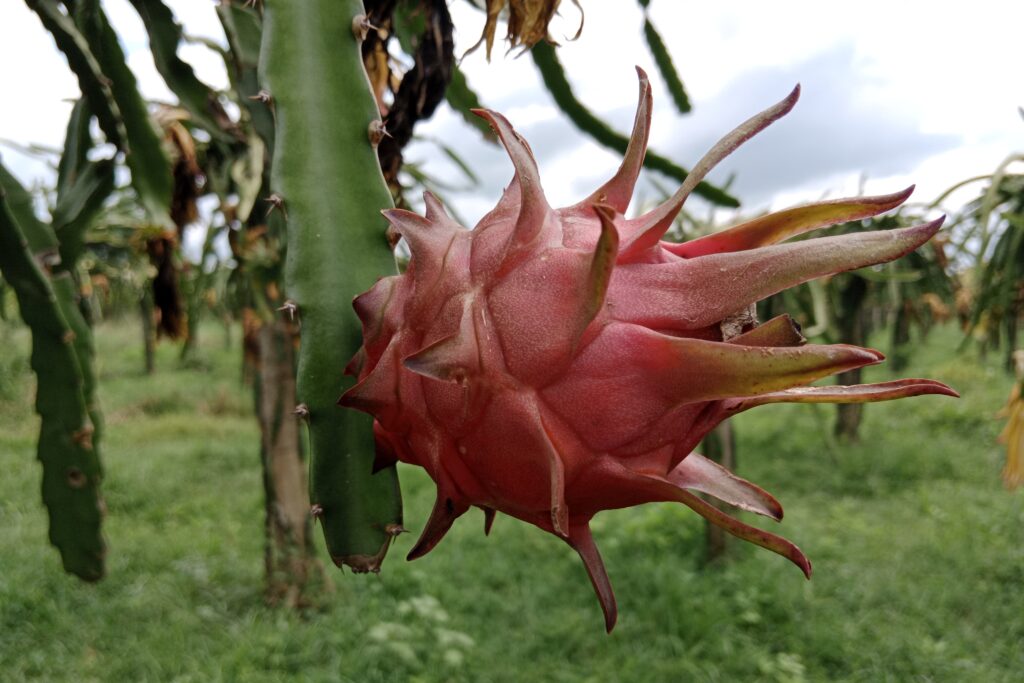

Pingback: Squash Farming Profit Per Acre -